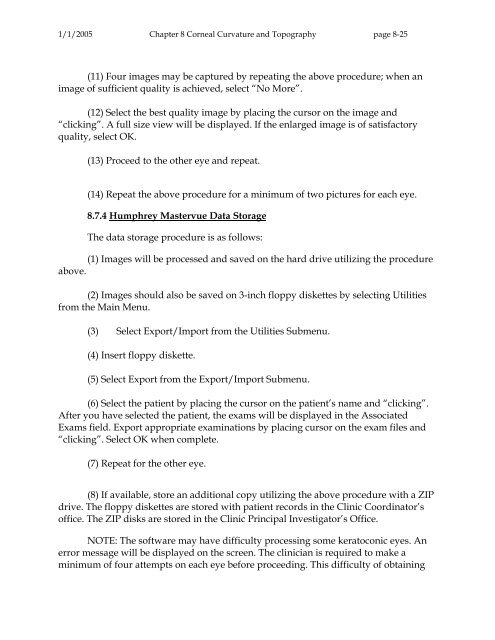OM t of c.iii - Vision Research Coordinating Center - Washington ...
OM t of c.iii - Vision Research Coordinating Center - Washington ...
OM t of c.iii - Vision Research Coordinating Center - Washington ...
You also want an ePaper? Increase the reach of your titles
YUMPU automatically turns print PDFs into web optimized ePapers that Google loves.
1/1/2005 Chapter 8 Corneal Curvature and Topography page 8-25<br />
(11) Four images may be captured by repeating the above procedure; when an<br />
image <strong>of</strong> sufficient quality is achieved, select “No More”.<br />
(12) Select the best quality image by placing the cursor on the image and<br />
“clicking”. A full size view will be displayed. If the enlarged image is <strong>of</strong> satisfactory<br />
quality, select OK.<br />
(13) Proceed to the other eye and repeat.<br />
(14) Repeat the above procedure for a minimum <strong>of</strong> two pictures for each eye.<br />
8.7.4 Humphrey Mastervue Data Storage<br />
The data storage procedure is as follows:<br />
(1) Images will be processed and saved on the hard drive utilizing the procedure<br />
above.<br />
(2) Images should also be saved on 3-inch floppy diskettes by selecting Utilities<br />
from the Main Menu.<br />
(3) Select Export/Import from the Utilities Submenu.<br />
(4) Insert floppy diskette.<br />
(5) Select Export from the Export/Import Submenu.<br />
(6) Select the patient by placing the cursor on the patient’s name and “clicking”.<br />
After you have selected the patient, the exams will be displayed in the Associated<br />
Exams field. Export appropriate examinations by placing cursor on the exam files and<br />
“clicking”. Select OK when complete.<br />
(7) Repeat for the other eye.<br />
(8) If available, store an additional copy utilizing the above procedure with a ZIP<br />
drive. The floppy diskettes are stored with patient records in the Clinic Coordinator’s<br />
<strong>of</strong>fice. The ZIP disks are stored in the Clinic Principal Investigator’s Office.<br />
NOTE: The s<strong>of</strong>tware may have difficulty processing some keratoconic eyes. An<br />
error message will be displayed on the screen. The clinician is required to make a<br />
minimum <strong>of</strong> four attempts on each eye before proceeding. This difficulty <strong>of</strong> obtaining
















